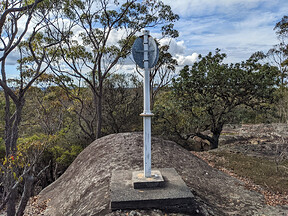Survey markers can be eligible if they meet the acceptance criteria for encouraging exploration. Good examples can include survey markers located at the peaks of hills and mountains, at the ends of peninsulas, or on other noteworthy local landforms, so long as they can be accessed by pedestrians through the use of trails or similar paths. Some survey markers might also have an interesting and unique history which may make them eligible; in these cases, submitters should ensure that they provide sufficient context in their titles, descriptions, and supporting information.
Survey markers are not inherently eligible and reviewers should evaluate each one based on the Wayfarer criteria. Mass-produced markers, even if stamped with a unique identification number, are not eligible if they are located in unremarkable locations.
The following are examples of eligible survey markers.
![]() Above is an example of a permanent survey mark on a mountaintop and represents a great place to explore. Referencing marker databases and providing additional context in your supporting information can help reviewers verify your claims.
Above is an example of a permanent survey mark on a mountaintop and represents a great place to explore. Referencing marker databases and providing additional context in your supporting information can help reviewers verify your claims.
![]() Some survey markers such as this one which celebrates the 150th year since the foundation of the local state are eligible due to their historical significance and value to local exploration, however, the submitter should provide sufficient evidence.
Some survey markers such as this one which celebrates the 150th year since the foundation of the local state are eligible due to their historical significance and value to local exploration, however, the submitter should provide sufficient evidence.
![]() Above is an example of an ineligible survey marker. It is mass-produced, located in an unremarkable location with little value for exploration, and is potentially unsafe for pedestrians due to its location on the verge of the road.
Above is an example of an ineligible survey marker. It is mass-produced, located in an unremarkable location with little value for exploration, and is potentially unsafe for pedestrians due to its location on the verge of the road.


